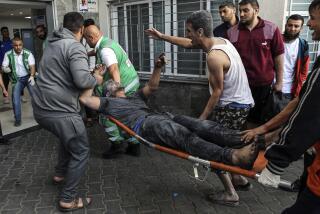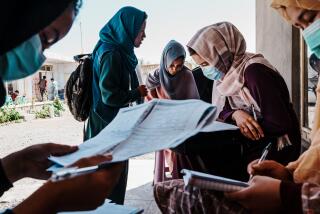Phase 2: Redefine What It Is to ‘Win’
Historians are uneasy when asked about the “lessons of history.” That’s because changed times and different circumstances make those lessons ambiguous, obsolete or unwise. Generals, for example, tend to learn from their mistakes of the last war and so create whole new blunders in the next one.
Not so long ago, we heard from the swivel-chair generals of the editorial pages and chat shows that the coalition bombing in Afghanistan was having no effect on the Taliban save mustering the entire population to hate us and that the Northern Alliance had little military value. Even the real generals were remarking on how “tough” the Taliban was and warning of a city-by-city struggle.
Now, children are flying kites in Herat, women are shedding burkas in Mazar-i-Sharif and newly shaven men in Kabul are blessing America and playing disco music.
What happened? To paraphrase Shakespeare, the fault lies not in our spy satellites but in our mind-set. We saw the Taliban through Western eyes.
The generals and pundits may have been hypnotized by their own metaphors. Why did we build up the Taliban to be 50,000 fanatics who would bleed for every crag of Kush rather than surrender? We heard analogies to the Japanese at Iwo Jima, the Viet Cong in their warrens and the German Waffen SS on the eastern front. And of course, there were the scary precedents of the defeats of the British and the Russians.
Yet all those comparisons were flawed. The British in the 1800s had no native support, no air power and no eyes in the sky. The Russians had no heavy bombers and few guided munitions, mostly used World War II tactics and faced an enemy supplied by another superpower. The fanatical moujahedeen of the late 1970s and 1980s are mostly dead, crippled or retired. Except for Osama bin Laden’s foreign legions, most current Taliban warriors were pressed into service or were booty hunters. They have little combat experience; beating up women and torturing prisoners is more their style. More critically, just because something is on a map with lines at its edges doesn’t make it a nation-state. Decades of war not only destroyed nearly every building larger than a hut in Afghanistan but also every institution and loyalty beyond the valley and the chief. Ask people in Kabul who they are, and they’ll say Tajik or Pushtun; Afghan is an afterthought.
Our understanding of the Taliban is as murky. What we call the Taliban “army” is a loose alliance of regional warlords, militias, foreign legions and a few young fanatics. We are confusing tribal cultures with national cultures.
Now the U.S. moves to the second phase of war, which could be over in weeks but also might take years: finding and flushing out the Taliban and Al Qaeda leadership and die-hards. We have to be prepared to redefine the meaning of victory. No one, for example, can conquer Afghanistan; every boulder holds a new threat. It is possible, however, to gain a rough consensus of all the factions that a central government has to be respected (if not necessarily obeyed) and that harboring foreign terrorists is not profitable.
In other countries that protect or sponsor terrorists, there are contradictions, factions and different degrees of national consciousness. We can’t make war on them all. But diplomacy, threats, bribes, underwriting revolutions or even appeals to goodwill might achieve some of our objectives.
Finally, we can’t become slaves to the supposed lessons of our success. Our enemies aren’t monolithic; neither are our true friends or allies of convenience. This isn’t a clash of civilizations but a power struggle of factions, of which the U.S. is just one.


